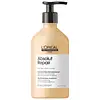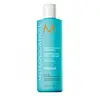What's inside
What's inside
 Key Ingredients
Key Ingredients

 Benefits
Benefits

 Concerns
Concerns

 Ingredients Side-by-side
Ingredients Side-by-side

Water
Skin ConditioningSodium Laureth Sulfate
CleansingCocamidopropyl Betaine
CleansingDimethicone
EmollientSodium Chloride
MaskingCitric Acid
BufferingHexylene Glycol
EmulsifyingSodium Benzoate
MaskingSodium Hydroxide
BufferingAmodimethicone
Carbomer
Emulsion StabilisingGuar Hydroxypropyltrimonium Chloride
Skin ConditioningTrideceth-10
CleansingGlycerin
HumectantSalicylic Acid
MaskingGlycol Distearate
EmollientLinalool
PerfumingMica
Cosmetic ColorantPEG-100 Stearate
Hexyl Cinnamal
PerfumingPhenoxyethanol
PreservativeSteareth-6
EmulsifyingCoco-Betaine
CleansingTrideceth-3
EmulsifyingCI 77891
Cosmetic ColorantLimonene
PerfumingChenopodium Quinoa Seed Extract
Skin ConditioningAcetic Acid
BufferingFumaric Acid
BufferingHydrolyzed Wheat Protein
Skin ConditioningCI 19140
Cosmetic ColorantHydrolyzed Corn Protein
Skin ConditioningHydrolyzed Soy Protein
HumectantCI 17200
Cosmetic ColorantParfum
MaskingWater, Sodium Laureth Sulfate, Cocamidopropyl Betaine, Dimethicone, Sodium Chloride, Citric Acid, Hexylene Glycol, Sodium Benzoate, Sodium Hydroxide, Amodimethicone, Carbomer, Guar Hydroxypropyltrimonium Chloride, Trideceth-10, Glycerin, Salicylic Acid, Glycol Distearate, Linalool, Mica, PEG-100 Stearate, Hexyl Cinnamal, Phenoxyethanol, Steareth-6, Coco-Betaine, Trideceth-3, CI 77891, Limonene, Chenopodium Quinoa Seed Extract, Acetic Acid, Fumaric Acid, Hydrolyzed Wheat Protein, CI 19140, Hydrolyzed Corn Protein, Hydrolyzed Soy Protein, CI 17200, Parfum
Water
Skin ConditioningSodium Lauroyl Sarcosinate
CleansingCocamidopropyl Hydroxysultaine
CleansingCocamidopropyl Betaine
CleansingGlycerin
HumectantCocamide Dipa
EmulsifyingPolyquaternium-70
PEG-150 Pentaerythrityl Tetrastearate
EmulsifyingArgania Spinosa Kernel Oil
EmollientTilia Tomentosa Bud Extract
Skin ConditioningChondrus Crispus Extract
Skin ConditioningAscophyllum Nodosum Extract
Skin ConditioningLaminaria Saccharina Extract
Skin ProtectingPalmaria Palmata Extract
Skin ProtectingUndaria Pinnatifida Extract
Skin ConditioningCitric Acid
BufferingTocopherol
AntioxidantRetinyl Palmitate
Skin ConditioningGlycol Distearate
EmollientPEG-6 Caprylic/Capric Glycerides
EmulsifyingDiethylhexyl Syringylidenemalonate
Skin ProtectingCaprylic/Capric Triglyceride
MaskingLaureth-10
EmulsifyingCocamide Mea
EmulsifyingPolysorbate 20
EmulsifyingPEG-20 Glyceryl Laurate
EmulsifyingAcrylates/Palmeth-25 Acrylate Copolymer
Linoleic Acid
CleansingParfum
MaskingDipropylene Glycol
HumectantButylene Glycol
HumectantCaprylyl Glycol
EmollientTetrasodium EDTA
Chlorphenesin
AntimicrobialPhenoxyethanol
PreservativePotassium Sorbate
PreservativeSodium Benzoate
MaskingWater, Sodium Lauroyl Sarcosinate, Cocamidopropyl Hydroxysultaine, Cocamidopropyl Betaine, Glycerin, Cocamide Dipa, Polyquaternium-70, PEG-150 Pentaerythrityl Tetrastearate, Argania Spinosa Kernel Oil, Tilia Tomentosa Bud Extract, Chondrus Crispus Extract, Ascophyllum Nodosum Extract, Laminaria Saccharina Extract, Palmaria Palmata Extract, Undaria Pinnatifida Extract, Citric Acid, Tocopherol, Retinyl Palmitate, Glycol Distearate, PEG-6 Caprylic/Capric Glycerides, Diethylhexyl Syringylidenemalonate, Caprylic/Capric Triglyceride, Laureth-10, Cocamide Mea, Polysorbate 20, PEG-20 Glyceryl Laurate, Acrylates/Palmeth-25 Acrylate Copolymer, Linoleic Acid, Parfum, Dipropylene Glycol, Butylene Glycol, Caprylyl Glycol, Tetrasodium EDTA, Chlorphenesin, Phenoxyethanol, Potassium Sorbate, Sodium Benzoate
 Reviews
Reviews

Ingredients Explained
These ingredients are found in both products.
Ingredients higher up in an ingredient list are typically present in a larger amount.
Citric Acid is an alpha hydroxy acid (AHA) naturally found in citrus fruits like oranges, lemons, and limes.
Like other AHAs, citric acid can exfoliate skin by breaking down the bonds that hold dead skin cells together. This helps reveal smoother and brighter skin underneath.
However, this exfoliating effect only happens at high concentrations (20%) which can be hard to find in cosmetic products.
Due to this, citric acid is usually included in small amounts as a pH adjuster. This helps keep products slightly more acidic and compatible with skin's natural pH.
In skincare formulas, citric acid can:
While it can provide some skin benefits, research shows lactic acid and glycolic acid are generally more effective and less irritating exfoliants.
Most citric acid used in skincare today is made by fermenting sugars (usually from molasses). This synthetic version is identical to the natural citrus form but easier to stabilize and use in formulations.
Read more about some other popular AHA's here:
Learn more about Citric AcidCocamidopropyl Betaine is a fatty acid created by mixing similar compounds in coconut oil and dimethylaminopropylamine, a compound with two amino groups.
This ingredient is a surfactant and cleanser. It helps gather the dirt, pollutants, and other impurities in your skin to be washed away. It also helps thicken a product and make the texture more creamy.
Being created from coconut oil means Cocamidopropyl Betaine is hydrating for the skin.
While Cocamidopropyl Betaine was believed to be an allergen, a study from 2012 disproved this. It found two compounds in unpure Cocamidopropyl Betaine to be the irritants: aminoamide and 3-dimethylaminopropylamine. High-grade and pure Cocamidopropyl Betaine did not induce allergic reactions during this study.
Learn more about Cocamidopropyl BetaineGlycerin is already naturally found in your skin. It helps moisturize and protect your skin.
A study from 2016 found glycerin to be more effective as a humectant than AHAs and hyaluronic acid.
As a humectant, it helps the skin stay hydrated by pulling moisture to your skin. The low molecular weight of glycerin allows it to pull moisture into the deeper layers of your skin.
Hydrated skin improves your skin barrier; Your skin barrier helps protect against irritants and bacteria.
Glycerin has also been found to have antimicrobial and antiviral properties. Due to these properties, glycerin is often used in wound and burn treatments.
In cosmetics, glycerin is usually derived from plants such as soybean or palm. However, it can also be sourced from animals, such as tallow or animal fat.
This ingredient is organic, colorless, odorless, and non-toxic.
Glycerin is the name for this ingredient in American English. British English uses Glycerol/Glycerine.
Learn more about GlycerinGlycol Distearate serves as a pearlizing or opacifying agent in cosmetic products.
It's often included in cleansers and haircare products to give them a lustrous or shimmering appearance.
It is derived from stearic acid, a natural fatty acid commonly found in vegetable oils and animal fats.
Glycol Distearate isn't fungal acne safe.
Learn more about Glycol DistearateParfum is a catch-all term for an ingredient or more that is used to give a scent to products.
Also called "fragrance", this ingredient can be a blend of hundreds of chemicals or plant oils. This means every product with "fragrance" or "parfum" in the ingredients list is a different mixture.
For instance, Habanolide is a proprietary trade name for a specific aroma chemical. When used as a fragrance ingredient in cosmetics, most aroma chemicals fall under the broad labeling category of “FRAGRANCE” or “PARFUM” according to EU and US regulations.
The term 'parfum' or 'fragrance' is not regulated in many countries. In many cases, it is up to the brand to define this term.
For instance, many brands choose to label themselves as "fragrance-free" because they are not using synthetic fragrances. However, their products may still contain ingredients such as essential oils that are considered a fragrance by INCI standards.
One example is Calendula flower extract. Calendula is an essential oil that still imparts a scent or 'fragrance'.
Depending on the blend, the ingredients in the mixture can cause allergies and sensitivities on the skin. Some ingredients that are known EU allergens include linalool and citronellol.
Parfum can also be used to mask or cover an unpleasant scent.
The bottom line is: not all fragrances/parfum/ingredients are created equally. If you are worried about fragrances, we recommend taking a closer look at an ingredient. And of course, we always recommend speaking with a professional.
Learn more about ParfumPhenoxyethanol is a preservative that has germicide, antimicrobial, and aromatic properties. Studies show that phenoxyethanol can prevent microbial growth. By itself, it has a scent that is similar to that of a rose.
It's often used in formulations along with Caprylyl Glycol to preserve the shelf life of products.
Sodium Benzoate is a preservative. It's used in both cosmetic and food products to inhibit the growth of mold and bacteria. It is typically produced synthetically.
Both the US FDA and EU Health Committee have approved the use of sodium benzoate. In the US, levels of 0.1% (of the total product) are allowed.
Sodium benzoate works as a preservative by inhibiting the growth of bacteria inside of cells. It prevents the cell from fermenting a type of sugar using an enzyme called phosphofructokinase.
It is the salt of benzoic acid. Foods containing sodium benzoate include soda, salad dressings, condiments, fruit juices, wines, and snack foods.
Studies for using ascorbic acid and sodium benzoate in cosmetics are lacking, especially in skincare routines with multiple steps.
We always recommend speaking with a professional, such as a dermatologist, if you have any concerns.
Learn more about Sodium BenzoateWater. It's the most common cosmetic ingredient of all. You'll usually see it at the top of ingredient lists, meaning that it makes up the largest part of the product.
So why is it so popular? Water most often acts as a solvent - this means that it helps dissolve other ingredients into the formulation.
You'll also recognize water as that liquid we all need to stay alive. If you see this, drink a glass of water. Stay hydrated!
Learn more about Water